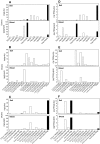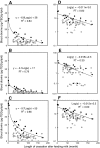Polychlorinated dioxins, furans, and biphenyls in blood of children and adults living in a dioxin-contaminated area in Tokyo
- PMID: 21432212
- PMCID: PMC2999684
- DOI: 10.1007/s12199-010-0156-z
Polychlorinated dioxins, furans, and biphenyls in blood of children and adults living in a dioxin-contaminated area in Tokyo
Abstract
The soil of a residential area in Tokyo was found to contain dioxins, namely polychlorinated dioxins, furans, and dioxin-like biphenyls, the levels of which exceeded the environmental guideline [1,000 pg toxic equivalent (TEQ)/g] by up to 6.8 times. To assess the exposure levels of people living in this area and to study the possible relationship of blood dioxin concentrations of children with breast milk and/or formula feeding, a health survey was carried out in 2006, involving a total of 138 people, including 66 children aged 3-15 years, and blood dioxin concentrations and the characteristics and lifestyles of these people were analyzed. Mean ± standard error of the mean (SEM) of blood dioxin concentrations (pg/g-lipid) of group 1 (3-6 years old), group 2 (7-15 years old), and group 3 (≥16 years old) were 13 ± 1.9, 6.6 ± 0.65, and 10 ± 0.54, respectively. The congener/isomer profile of dioxins in blood samples differed markedly from that of the contaminated soil samples. According to the feeding mode of children, blood dioxin concentrations (pg/g-lipid) were 17 ± 2.9 for breast milk only, 7.4 ± 0.82 for both breast milk and formula, and 4.7 ± 1.1 for formula only, with a significant difference from one another. We conclude that people living in the dioxin-contaminated area are less likely to be exposed to excessive amounts of dioxins, and that blood dioxin concentrations of children aged 3-15 years seem to be strongly affected by breast feeding duration.
Figures




Similar articles
-
Concentrations of polychlorinated dibenzo-p-dioxins, polychlorinated dibenzofurans, and dioxin-like polychlorinated biphenyls in blood and breast milk collected from 60 mothers in Sapporo City, Japan.Chemosphere. 2008 Jul;72(8):1152-8. doi: 10.1016/j.chemosphere.2008.03.050. Epub 2008 May 12. Chemosphere. 2008. PMID: 18474391
-
Relationship between the concentrations of polychlorinated dibenzo-p-dioxins, polychlorinated dibenzofurans, and polychlorinated biphenyls in maternal blood and those in breast milk.Chemosphere. 2010 Jan;78(2):185-92. doi: 10.1016/j.chemosphere.2009.09.047. Epub 2009 Oct 21. Chemosphere. 2010. PMID: 19850319
-
Correlation coefficients between the dioxin levels in mother's milk and the distances to the nearest waste incinerator which was the largest source of dioxins from each mother's place of residence in Tokyo, Japan.Chemosphere. 2005 Dec;61(9):1256-62. doi: 10.1016/j.chemosphere.2005.03.096. Chemosphere. 2005. PMID: 15922405
-
Human uptake of persistent chemicals from contaminated soil: PCDD/Fs and PCBs.Regul Toxicol Pharmacol. 2010 Jun;57(1):43-54. doi: 10.1016/j.yrtph.2009.12.005. Epub 2009 Dec 24. Regul Toxicol Pharmacol. 2010. PMID: 20035816 Review.
-
Risk assessments of polychlorinated dibenzo- p-dioxins, polychlorinated dibenzofurans, and dioxin-like polychlorinated biphenyls in food.Mol Nutr Food Res. 2006 Oct;50(10):885-96. doi: 10.1002/mnfr.200500247. Mol Nutr Food Res. 2006. PMID: 17009211 Review.
Cited by
-
The Relationship of Dioxin Levels in Serum of 9-Year-Old Vietnamese Children and Their Mothers' Breast Milk.Toxics. 2022 Mar 25;10(4):155. doi: 10.3390/toxics10040155. Toxics. 2022. PMID: 35448416 Free PMC article.
-
Duration of breastfeeding and serum PCB 153 concentrations in children.Environ Res. 2015 Jan;136:35-9. doi: 10.1016/j.envres.2014.09.036. Epub 2014 Nov 20. Environ Res. 2015. PMID: 25460618 Free PMC article.
References
-
- Schecter A, Gasiewicz TA, editors. Dioxin and Health. 2nd ed. Hoboken: Wiley; 2003. p. 952.
-
- World Health Organization. Consultation on assessment of the health risk of dioxins; re-evaluation of the tolerable daily intake (TDI): executive summary. Food Addit Contam. 2000;17:223–40. - PubMed
-
- The Ministry of Health Labour and Welfare. Survey results on health effects of dioxins in workers who were engaged in incineration-related labors at Osaka Toyono-gun Cleanup Center. 2004. http://www.mhlw.go.jp/topics/2004/10/tp1020-2.html (in Japanese).
-
- Matsuura N, Uchiyama T, Tada H, Nakamura Y, Kondo N, Morita M, et al. Effects of dioxins and polychlorinated biphenyls (PCBs) on thyroid function in infants born in Japan—the second report from research on environmental health. Chemosphere. 2001;45:1167–1171. doi: 10.1016/S0045-6535(01)00050-9. - DOI - PubMed
